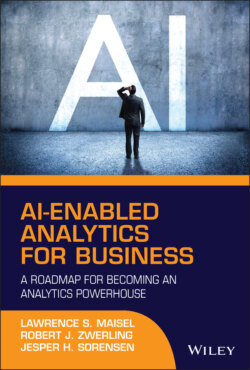Читать книгу AI-Enabled Analytics for Business - Lawrence S. Maisel - Страница 9
CHAPTER 1 A Primer on AI-Enabled Analytics for Business
ОглавлениеKnowledge will forever govern ignorance; and a people who mean to be their own governors must arm themselves with the power which knowledge gives.
—James Madison1
Artificial intelligence (AI) dates back over 75 years. Alan Turing, a mathematician, explored the mathematical possibility of AI, suggesting that “humans use available information as well as reason in order to solve problems and make decisions,” and if this premise is true, then machines can do so too. This was the basis of his 1950 paper “Computing Machinery and Intelligence,” in which he discussed “how to build intelligent machines and how to test their intelligence.”2
So, what is artificial intelligence? Very broadly speaking, it is the ability of a machine to make decisions that are done by humans. But what does that mean, what does AI look like, and how will it change our lives and society?
We all know that AI, sooner or later, will be part of all businesses. But when it is part of the business is entirely dependent on what each executive knows and understands about AI and analytics. And here lies the chasm between the early adopters and the rest of the pack.
According to Grant Thornton's 21 May 2019 report “The Vital Role of the CFO in Digital Transformation,” the 2019 CFO Survey of Tech Adoption covered several technologies, including advanced analytics and machine learning. 38% of respondents indicated that they currently implemented advanced analytics, and 29% are planning implementations in the next 12 months. For machine learning technology, the survey results said that 29% had implemented it and 24% were planning to implement in the next 12 months. Impressive returns from the survey's sample set, and indicative of the priority of and accelerating trend in the adoption of analytics and AI throughout business. However, while conveying progress in its best light, this survey is a poor showing of a glass that is not even half full.
Implementations of AI are just scratching the surface, as projects have been highly targeted to only certain areas of the business and for certain tasks. So, while the movement to incorporate advanced analytics is in the right direction, there are many more failures than successes. This is disturbingly bad news, which we shall learn largely rests with executives. The good news is that AI and analytics failures are eminently avoidable.
Many executives lack clarity of vision and voice to how they will navigate their business, division, group, or department through the adoption of analytics and AI. Other executives think they know what AI enablement means but are often working from poorly defined terms or misconceptions about analytics. Their knee-jerk response is to hire consultants and buy AI-enabled analytics software without fully understanding how analytics will be used to drive decisions.
Cries of “We need better forecasting” and “What factors are driving our business?” and “We must get smarter about what we do” echo in boardrooms and executive conference rooms. But how exactly is this done? Not what, but how? The “what,” many an executive has read from a mountain of consulting reports; but the “how” is unclear and is why too many businesses are lagging in their adoption of AI and analytics.
In this chapter, we lay the foundation for this book by untangling terms and terminology with definitions and giving a ground-level introduction in select technologies (for the purpose of understanding, not to become experts). We will pursue a high-level discussion of AI, machine learning (ML), and analysis vs. analytics, followed by an explanation of business intelligence and data visualization and how these are different from analytics. We will introduce the application of AI-enabled analytics in the context of insights and the contrast between biased vs. unbiased predictions. Finally, we will position the importance of AI by discussing its ROI.
